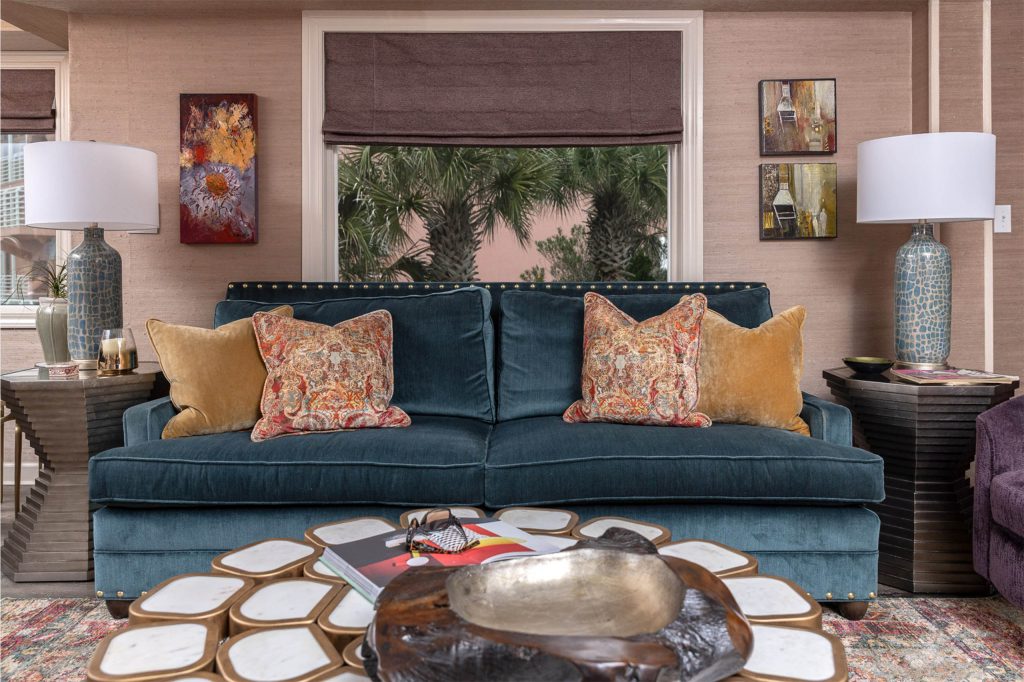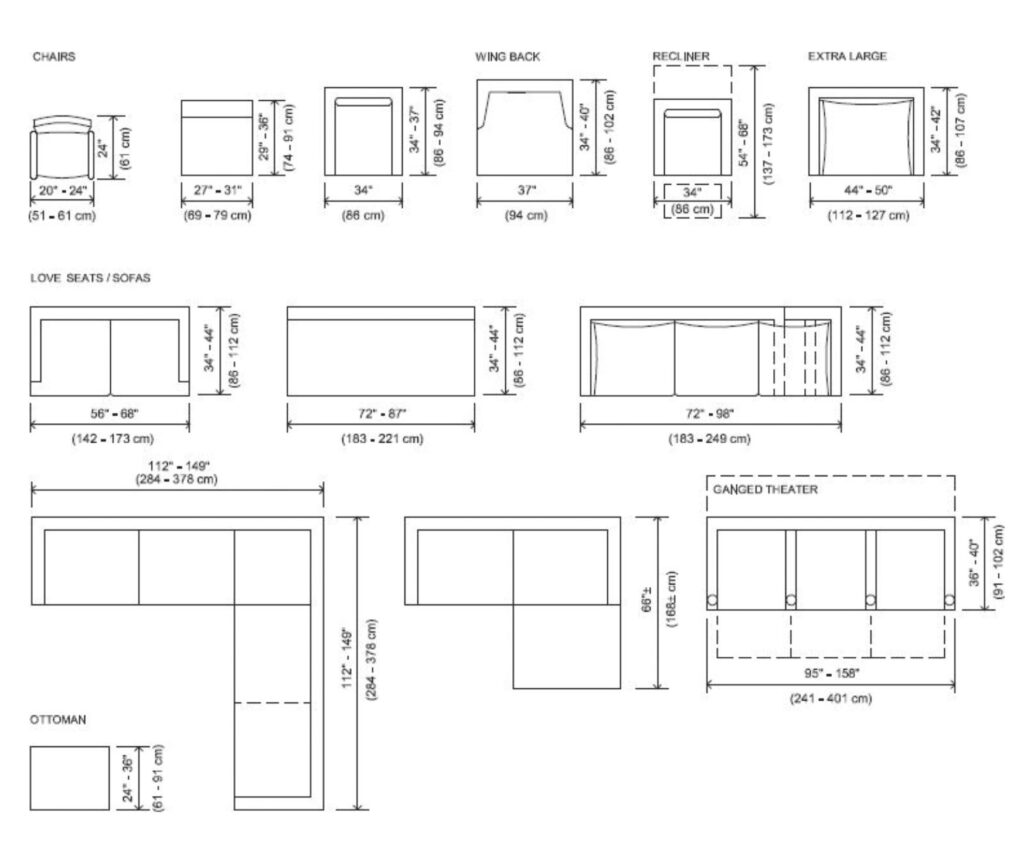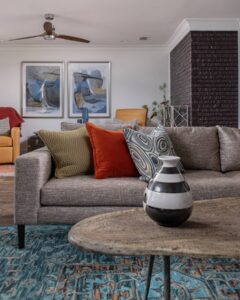Finding the Right Sofa for Comfort and Style
Your sofa is the heart of your living room—the spot for cozy movie nights, casual gatherings, or quiet afternoons with a book. Choosing the right sofa involves more than just picking a style; it means finding the right size and dimensions to fit your space and lifestyle. This is crucial not only for comfort but also for the flow and functionality of the entire room. You might even avoid a not-so-nice discussion with your spouse or a lot of cursing and profuse sweating by taking a few minutes to properly measure ahead of time.
From understanding standard dimensions to measuring your room precisely, this guide will walk you through everything you need to know about selecting and fitting a sofa. Grab your tape measure and let’s get started!
Key Terms to Know When Shopping for Sofas
- Width – The distance from the edge of one armrest to the edge of the other. Sofa width affects how the sofa fits in your space and is one of the primary measurements to consider.
- Depth – The distance from the front edge of the sofa seat to the back. This affects comfort and seating posture, especially for taller individuals.
- Seat Depth – Measured from the front edge of the seat cushion to the back edge, this affects how much room you have to sit back and relax.
- Seat Height – The distance from the floor to the top of the seat cushion. This can vary and will affect comfort depending on user height.
- Back Height – The distance from the top of the backrest to the floor. This determines the sofa’s overall profile and impacts the level of support for users.
- Arm Height – The height from the floor to the top of the armrest. Ensuring the arm height works with your side tables or coffee tables is essential for a balanced layout.
Always look for the spec sheet of the sofa you are interested in, that should always be located on either the website or your designer should be able to provide it to you and if not, try to steer clear of that particular brand.

Step-by-Step Guide: Measuring for Your Sofa
1. Measure Your Space Accurately
Start by measuring the area where you plan to place your sofa. Knowing the exact space you have will help you decide between a compact loveseat or apartment style, a standard three-seater, or a more expansive sectional. Take note of:
- Width and Depth of the Room: Measure the length and width of the area where the sofa will go and the depth of the space to ensure it doesn’t block pathways or overpower the room.
- Clearance and Doorways: Measure doorways, stairwells, and any other entry points to make sure the sofa can be maneuvered into your space. There’s nothing worse than realizing you don’t have a clear or easy way to get it into the house on delivery day! Also, pay attention to any sharp turns or low ceilings en route to your sofa’s new location.
- Adjacent Furniture: Consider other furniture near the sofa. Measure the height of side tables, coffee tables, and shelving to ensure they’re proportionate to your sofa’s dimensions.
2. Consider Room Flow and Traffic Patterns
Think about how people move through your room. Make sure to leave at least 18-24 inches of clearance around the sofa for easy movement. In smaller spaces, a slim-arm sofa can save inches without compromising seating.
3. Use Painter’s Tape to Visualize
Once you’ve identified where you want your sofa, use painter’s tape to outline its footprint on the floor. This will give you a better sense of scale and show how much space the sofa will occupy. Then, you can make any necessary adjustments before purchasing.
For a step-by-step visual guide, check out this video:
Standard Sofa Sizes and Dimensions
Average Sofa Sizes
Here’s a quick breakdown of standard sofa dimensions:
- Two-Seater (Loveseat): 52-65 inches wide, 38 inches deep. Perfect for smaller rooms, they fit well in apartments and can act as additional seating in larger spaces.
- Three-Seater Sofa: 84-90 inches wide, 38 inches deep, 34 inches high. This size works well for most living rooms, balancing comfort with space efficiency.
- Four-Seater: 100-117 inches wide, typically around 38 inches deep. Ideal for spacious living rooms where they can serve as the main seating area.
- Sectional Sofas: Sectionals vary widely because they are highly customizable, but standard L-shaped sectionals typically range from 90 to 120 inches on the longest side. For large living areas or open-concept spaces, sectionals can provide both versatility and room division.
These measurements are guidelines, so keep in mind that different styles and designs will vary slightly.

Other Dimensions to Consider
Your comfort on a sofa is influenced by several factors beyond the overall size. Here’s how to evaluate comfort based on seat depth, back height, and personal needs:
Sofa Depth and Seat Depth
Standard sofa depth is around 38 inches, while seat depth ranges from 21-24 inches. For a plush, lounging feel, look for a sofa with a deeper seat (26-28 inches). Shallower seats are great for more compact spaces or rooms designed for upright sitting. For taller individuals, deep seats offer more support, while shorter individuals may prefer a shallower seat for easier sitting. Knowing this dimension and how it affects you will be key to choosing the right sofa for your space.
Seat Height and Comfort Considerations
Seat height generally ranges from 17 to 20 inches. For taller individuals, a higher seat can offer more support, while shorter users may find a lower seat more comfortable. Seat height also impacts how well a sofa pairs with a coffee table, so it’s worth considering if you already have a table in place.
Back Height
Higher backs offer more neck support and are preferred for relaxed seating aka for movie lovers or those who love to lounge, while lower backs are ideal for modern aesthetics and open spaces, as they create fewer visual barriers so think of spaces where you might want an airy look.
Arm Height
This is important when using side tables and contributes to comfort when leaning against the sofa’s arms. Consider arm height carefully if you plan to pair the sofa with side tables or use it for lounging. A good rule of thumb is to always make sure the side table is within 2″ of the sofa arm’s height and that the side table is never further away from the sofa than 2-3″. You want to be able to sit that glass, book, or whatever else you holding down with ease so this is another important consideration when choosing the right sofa.
Slim vs. Wide Armrests
Slim arms save space and create a more streamlined look, while wide arms add a bold, comfortable presence.
What to Watch Out for When Shopping for Sofas
Avoid Overwhelming Small Spaces
In smaller rooms, avoid bulky sofas with oversized arms or high backs that could dominate the space. A compact loveseat or a “condo sofa” with slim arms can give you ample seating without crowding the room.
Don’t Forget Recliner Clearance
If you’re considering a reclining sofa, make sure you have enough room to fully extend the footrests. Wall-hugging recliners require minimal space behind them, but standard recliners need at least two feet of clearance. We prefer sofas that don’t look like they have motion capabilities, even if they do – ask us for our recommendations – Call In Detail Interiors!
Keep Scale and Proportion in Mind
Proportion is key to a well-balanced room. Choose a sofa that matches the scale of the other pieces in your room. For instance, if you have a low coffee table and slim side tables, avoid sofas with overly high backs and bulky arms.
Tips for Sectionals: Measuring and Placement
Sectional sofas are popular for their flexibility and spacious seating, but they come with unique measuring considerations.
Keep these things in mind when measuring for a sectional:
- Determine Overall Width and Depth: Measure from the outer edges of each piece, noting that sectionals often have different depths for each side, to ensure they’ll fit your space.
- Plan for “Extension” Pieces: Sectionals may include chaises, ottomans, or reclining features that require additional space. These extra pieces need more clearance so be sure to leave enough room around the piece to prevent any obstructions.
- Use Sectionals as Room Dividers: If you have an open floor plan, a sectional can act as a natural divider between areas without adding walls. Positioning a sectional with its back to a dining area, for example, helps define separate spaces between the dining and living areas.
- Outline with Tape: As with standard sofas, we recommend using painter’s tape to mark the placement of each sectional piece. This will help you visualize the layout and ensure easy navigation around the room.

Ensuring a Perfect Fit
Choosing the right sofa goes beyond aesthetics—size, proportions, and functionality are key factors that influence how well it integrates with your space. By knowing your room’s dimensions, understanding your desired sofa’s measurements, and visualizing its placement within your space, you can select a sofa that enhances your home’s comfort and style without overwhelming it – and avoid costly mistakes!
For measurement assistance, product recommendations, or to purchase the perfect sofa for you – visit our eclectic retail shop and showroom. We’re located at 1514 N 9th Avenue. Here are the directions: 1514 N 9th Ave – Google Maps
Plus, join our newsletter to be the first to know about new arrivals: https://www.indetailinteriors.com/newsletter/




